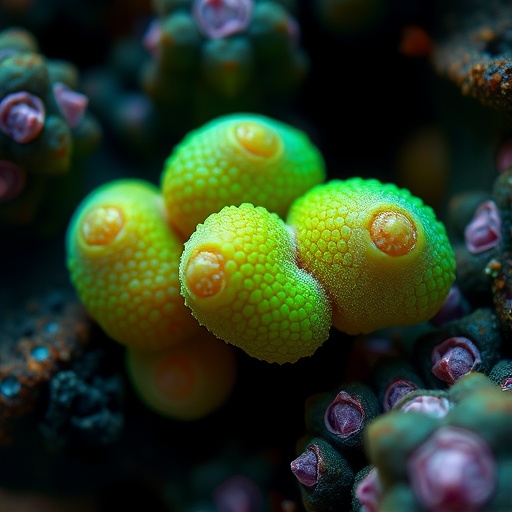In a groundbreaking study poised to reshape our understanding of pseudoexfoliation syndrome, researchers have identified a triad of biomarkers—homocysteine, ROCK2, and vimentin—that collectively serve as a convergent signature for this enigmatic ocular condition. Pseudoexfoliation syndrome is recognized as a significant contributor to glaucoma and other ocular complications, yet the underscoring pathophysiological mechanisms have remained elusive. This study, conducted by Sahoo, Mohanty, and Pankaj Alone, sheds new light on the interconnected roles these specific biomarkers play in the progression and management of the disease.
At the heart of this research lies homocysteine, an amino acid that has garnered attention for its association with various cardiovascular diseases and neurological disorders. Elevated levels of homocysteine have been linked to oxidative stress and inflammation, two critical components that can exacerbate tissue damage in the ocular microenvironment. The presence of high levels of homocysteine in patients with pseudoexfoliation syndrome signals a potential pathway through which oxidative stress contributes to the degeneration of the eye’s structural integrity, ultimately leading to increased intraocular pressure and glaucoma.
ROCK2, or Rho-associated protein kinase 2, has emerged as a pivotal player in the vascular and cellular responses to stress. This enzyme is integral to various signaling pathways that regulate cellular contraction and proliferation. Its overactivity has powerful implications for tissue remodeling, particularly in the context of ocular tissues exposed to pathological conditions. In the studied population, altered ROCK2 activity correlated with the severity of pseudoexfoliation, suggesting that targeting this enzyme may provide therapeutic avenues to mitigate disease progression.
Vimentin, an intermediate filament protein, is well-known for its role in maintaining cellular structure and integrity. It is typically associated with mesenchymal cells and has been implicated in the process of epithelial-to-mesenchymal transition (EMT), a phenomenon that plays a critical role in fibrosis and remodeling in various tissues. In pseudoexfoliation syndrome, aberrant expression levels of vimentin were observed, suggesting that it may serve as a biomarker for assessing disease state and progression. Notably, the link between vimentin dynamics and extracellular matrix remodeling provides insight into how the ocular environment adapts—sometimes maladaptively—over time.
Integrating these three biomarkers offers a more nuanced understanding of pseudoexfoliation syndrome beyond the traditional clinical assessments. By establishing a convergent signature comprised of homocysteine, ROCK2, and vimentin, the research team highlights the potential for a multifaceted diagnostic approach that could significantly enhance the stratification of patients based on risk factors and disease stage. This could ultimately lead to more personalized treatment protocols, optimizing outcomes for those afflicted by this complex condition.
The implications of these findings extend beyond just diagnostics. Current therapeutic strategies for managing pseudoexfoliation syndrome often lack specificity, leaving many patients vulnerable to complications. As the study establishes a clearer relationship between these biomarkers and the underlying pathophysiology, it opens up possibilities for targeted intervention strategies. For instance, if elevated homocysteine levels are driving oxidative damage, antioxidant therapies might be explored further as potential preventative measures.
Moreover, the research team advocated for further exploratory studies to validate these findings in larger cohorts. Establishing reliable biomarkers is essential for the early detection of pseudoexfoliation syndrome, allowing for timely interventions that can prevent irreversible vision loss. Previous studies have often fallen short in creating pathways that are translatable to clinical practice, but this triad of biomarkers presents a promising integration of laboratory findings into patient care.
Additionally, the study underlines the importance of multidisciplinary collaboration in addressing complex health issues. The interplay of molecular biology, clinical medicine, and potential pharmacotherapeutics exemplifies a contemporary approach to resolving the complexities of pseudoexfoliation syndrome. By fostering collaborations among geneticists, ophthalmologists, and pharmacologists, a more holistic model for research and treatment can be developed.
The potential rise of personalized medicine in ophthalmology is an exciting proposition, as ongoing research like this establishes foundational knowledge. As we advance, it is crucial to bridge these discoveries with clinical practices, ensuring that emerging therapies embody the intricacies discovered through such investigations. The promise of this triad as a reliable biomarker signature beckons further exploration into how chronic conditions could be better managed through precision medical approaches.
In conclusion, the identification of homocysteine, ROCK2, and vimentin as potential biomarkers for pseudoexfoliation syndrome signifies a substantial leap forward in how we conceptualize, diagnose, and treat this ocular condition. As research continues to evolve and validate these findings, the future of ophthalmology may very well hinge on our ability to embrace innovative biomarker strategies that enhance patient care and optimize therapeutic outcomes. The world of optical health is on the cusp of change, and this study stands at the forefront of that transformation.
As researchers delve deeper into the connections between these biomarkers and disease outcomes, the landscape of pseudoexfoliation syndrome could see a paradigm shift. Embracing comprehensive strategies that leverage advanced molecular insights could ultimately redefine urgency and efficacy in patient interventions. With ongoing dedication and research, the hope remains that devastating visual impairments from pseudoexfoliation syndrome may soon be relegated to the past, paving the way for better ocular health globally.
Subject of Research: Biomarkers in Pseudoexfoliation Syndrome
Article Title: Triad of Homocysteine, ROCK2, and Vimentin as a Convergent Biomarker Signature in Pseudoexfoliation.
Article References:
Sahoo, L., Mohanty, P.P. & Pankaj Alone, D. Triad of homocysteine, ROCK2 and vimentin as a convergent biomarker signature in pseudoexfoliation.
J Transl Med 23, 1326 (2025). https://doi.org/10.1186/s12967-025-07437-8
Image Credits: AI Generated
DOI: https://doi.org/10.1186/s12967-025-07437-8
Keywords: Pseudoexfoliation, biomarkers, homocysteine, ROCK2, vimentin, glaucoma, personalized medicine.




